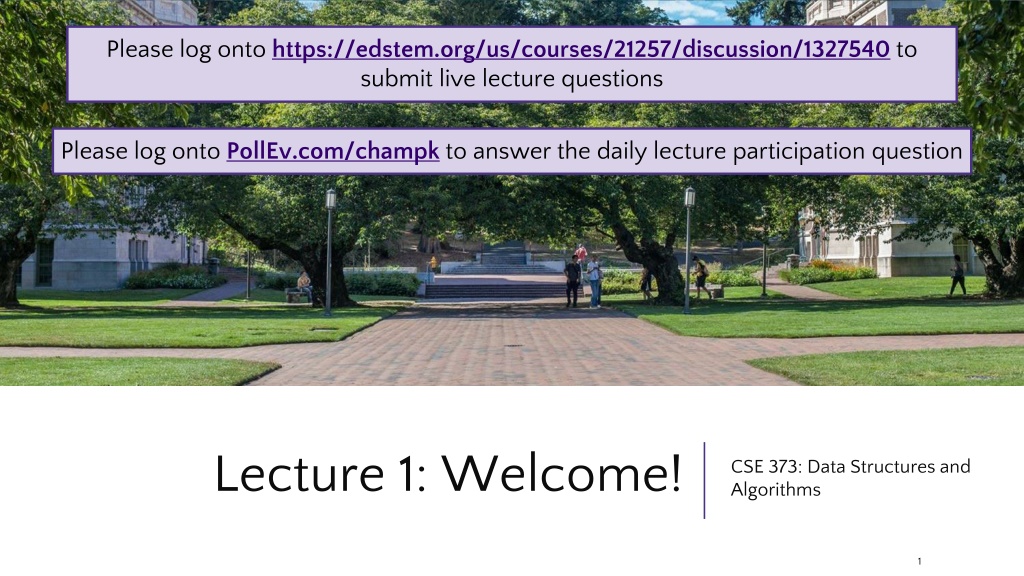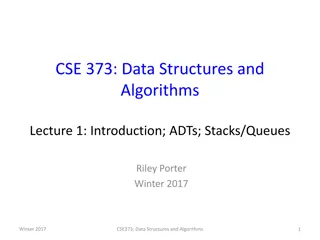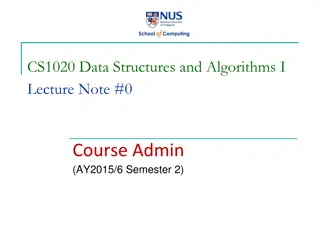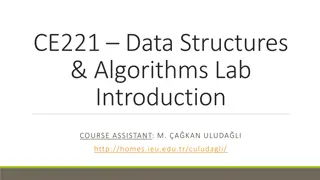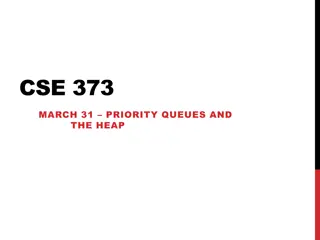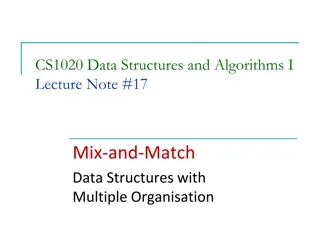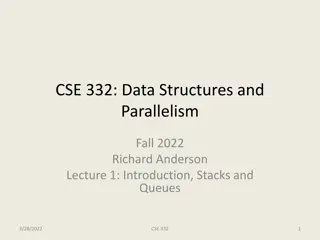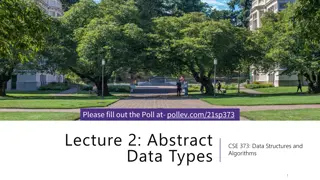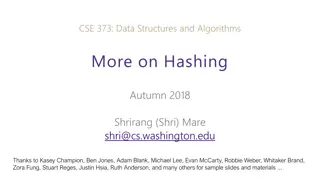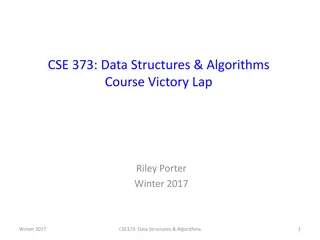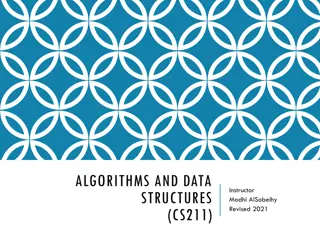CSE 373: Data Structures and Algorithms Overview
Welcome to CSE 373, a course focused on data structures and algorithms. Dive into topics like lists, stacks, queues, sorting algorithms, graphs, and more. Understand the importance of designing and analyzing data structures, preparing for technical interviews, and applying algorithms to solve complex problems. Join us for a comprehensive learning experience!
Download Presentation

Please find below an Image/Link to download the presentation.
The content on the website is provided AS IS for your information and personal use only. It may not be sold, licensed, or shared on other websites without obtaining consent from the author. Download presentation by click this link. If you encounter any issues during the download, it is possible that the publisher has removed the file from their server.
E N D
Presentation Transcript
Please log onto https://edstem.org/us/courses/21257/discussion/1327540 to submit live lecture questions Please log onto PollEv.com/champk to answer the daily lecture participation question Lecture 1: Welcome! CSE 373: Data Structures and Algorithms 1
Agenda -Introductions -Syllabus -Dust off data structure cobwebs -Meet the ADT -Questions CSE 373 22 SP CHAMPION 2
Welcome! We are SO excited to be fully back in person, but we know things are changing rapidly and the world is still a mess so please be kind to yourselves and one another -We are in this together -Humans first, students second -Patience, vulnerability, compassion We acknowledge that we are on the traditional land of the first people of Seattle, the Duwamish People past and present and honor with gratitude the land itself and the Duwamish Tribe. https://www.realrentduwamish.org/ 3 CSE 373 22 SP CHAMPION
Waitlist/ Overloads -I have told CSE the more the merrier, but technically I have no control over these things :/ -Email cse373@cs.washington.edu for all registration questions -Many students move around, likely a spot will open -Keep coming to lecture! CSE 373 21 SP CHAMPION 4
Hello! I am Kasey Champion (she/her) Technical Program Manager @ Google > Kasey has to go to her real job during the day L Previously: Technical Interview Content Team Lead @ Karat Previously: Software Engineer @ Microsoft Electrical Engineering and Computing @ UW champk@cs.washington.edu https://calendly.com/kasey-champion CSE 373 22 SP CHAMPION 5
Course Overview Course Topics -Data Structures and ADTs: lists, stacks, queues, sets, dictionaries, arrays, linked lists, trees, hash tables, priority queues, binary heaps and disjoint sets Course Goals -Design data structures and algorithms by implementing and maintaining invariants. -Analyze the runtime and design values of data structures and algorithms. -Algorithm analysis: Big O Notation, asymptotic analysis, P and NP complexity, Dynamic Programming optimization -Critique the application of data structures and algorithms towards complex problems. -Sorting algorithms: selection, insertion, merge, quick, more -Prepare for technical interviews -Graphs and graph algorithms: graph search, shortest path, minimum spanning trees 6 CSE 373 22 SP CHAMPION
Course Components Course Tools -Class webpage - Central location for all information -Course canvas - Gradebook -Zoom - Some Office Hours -Poll Everywhere - Lecture participation extra credit -Gradescope - Exercise distribution and submission -Ed Discussion board - Get help - Lecture questions - Find partners -GitLab - Project file distribution and submission -Anonymous Feedback Tool - Tell us how it s going Learning Components -Lectures - Recorded on Panopto - In-Person~ Please come hang out with us -Lecture Participation Polls - Graded on participation NOT correctness -Exercises - Sets of conceptual problems distributed via Gradescope -Projects - Programming assignments distributed via GitLab - Simulated Assessments - 2 this quarter, midterm and final - Test like questions without time limit - Groups, notes, internet searches allowed, but no staff help - After you complete the questions, we will release the solutions and you will submit your reflections on your answers to be graded -Office Hours - Please come hang out with us! 7 CSE 373 22 SP CHAMPION
A note about transitioning back to in-person Ed Discussion Board -Please feel free to use this to meet and engage with one another We are all figuring this out as we go! Lecture -Please be prepared to interact throughout the hour -Poll Everywhere Office Hours -Both online and in-person meetings, logistics coming later this week -Feel free to use this to meet and engage with one another (but make sure you are not sharing code, only ideas!) -Please be prepared to share your screen -Turn on mic Section -Similar to lecture -Please be prepared to work with other students -Discuss in small groups when working on problems Let us know what works! -Share what you ve seen elsewhere -Use the anonymous feedback form -Always happy to take suggestions / feedback 8 CSE 373 22 SP CHAMPION
Course Policies Turn In Policies -7 late days per student - use for projects or exercises - use up to 3 per assignment unless you speak to Kasey -Assignments - Solo or groups of 3 - Projects out/in on Wednesdays - Exercises out/in on Fridays - after all late days used up -5% for each 24-hour period turned in late -Simulated Exams - Students fill out take home assignment about Design Decisions - Open note/open book, no staff help - Students fill out code review worksheet - No late exams accepted -Participation Extra Credit - Poll everywhere open at start of lecture - Due before start of next lecture - No late polls will be accepted Grade Breakdown -Programming Projects (40%) -Written Exercises (30%) -Exam I (15%) -Exam II (15%) -Participation (EC round up to 0.05) Academic Misconduct -Don t share your code -Don t look at others code -Don t step by step -DO talk to one another about concepts and approaches -DO look things up on the internet -No posting code on discussion board or ANYWHERE online -We do run MOSS Accommodations and Extenuating Circumstances -Make sure you get the support you are entitled to via DRS - If you re having issues with DRS system reach out to Kasey -When in doubt, reach out! 9 CSE 373 22 SP CHAMPION
Questions? Clarification on syllabus, General complaining/moaning 10
What is this class about? CSE 142 INTRO TO PROGRAMMING CSE 143 OBJECT ORIENTED PROGRAMMING CSE 373 DATA STRUCTURES AND ALGORITHMS -Classes and Interfaces -Methods, variables and conditionals -Loops and recursion -Linked lists and binary trees -Sorting and Searching -O(n) analysis -Generics -Design decisions -Design analysis -Implementations of data structures -Debugging and testing -Abstract Data Types -Code Modeling -Complexity Analysis -Software Engineering Practices -Java syntax -Methods -Variables -Parameters & Returns -File IO -Scanner -Arrays Vocab Grammar Creative Writing 11 CSE 373 22 SP CHAMPION
Data Structures and Algorithms What are they anyway? 12
Basic Definitions Data Structure -A way of organizing and storing data -Examples from CSE 14X: arrays, linked lists, stacks, queues, trees Algorithm -A series of precise instructions to produce to a specific outcome -Examples from CSE 14X: binary search, merge sort, recursive backtracking CSE 373 20 SP CHUN & CHAMPION 13
Review: Clients vs Objects CLIENT CLASSES OBJECT CLASSES A class that is executable, in Java this means it contains a Main method A coded structure that contains data and behavior Start with the data you want to hold, organize the things you want to enable users to do with that data public static void main(String[] args) CSE 143 WI 18 WHITAKER BRAND 14
Abstract Data Types (ADT) Abstract Data Types -An abstract definition for expected operations and behavior -Defines the input and outputs, not the implementations Review: List - a collection storing an ordered sequence of elements -each element is accessible by a 0-based index -a list has a size (number of elements that have been added) -elements can be added to the front, back, or elsewhere -in Java, a list can be represented as an ArrayList object CSE 373 20 SP CHUN & CHAMPION 15
Review: Interfaces Example interface: A construct in Java that defines a set of methods that a class promises to implement -Interfaces give you an is-a relationship without code sharing. - A Rectangle object can be treated as a Shape but inherits no code. -Analogous to non-programming idea of roles or certifications: - "I'm certified as a CPA accountant. This assures you I know how to do taxes, audits, and consulting." - "I'm 'certified' as a Shape, because I implement the Shape interface. This assures you I know how to compute my area and perimeter." // Describes features common to all // shapes. public interface Shape { public double area(); public double perimeter(); } public interface name { public type name(type name, ..., type name); public type name(type name, ..., type name); ... public type name(type name, ..., type name); } CSE 373 20 SP CHUN & CHAMPION 16
Review: Java Collections Java provides some implementations of ADTs for you! ADTs Data Structures Lists List<Integer> a = new ArrayList<Integer>(); Stacks Stack<Character> c = new Stack<Character>(); Queues Queue<String> b = new LinkedList<String>(); Maps Map<String, String> d = new TreeMap<String, String>(); But some data structures you made from scratch why? Linked Lists - LinkedIntList was a collection of ListNode Binary Search Trees SearchTree was a collection of SearchTreeNodes CSE 373 20 SP CHUN & CHAMPION 17
Full Definitions Abstract Data Type (ADT) -A definition for expected operations and behavior -A mathematical description of a collection with a set of supported operations and how they should behave when called upon -Describes what a collection does, not how it does it -Can be expressed as an interface -Examples: List, Map, Set Data Structure -A way of organizing and storing related data points -An object that implements the functionality of a specified ADT -Describes exactly how the collection will perform the required operations -Examples: LinkedIntList, ArrayIntList CSE 373 19 WI - KASEY CHAMPION 18
ADTs well discuss this quarter -List -Set -Map -Stack -Queue -Priority Queue -Graph -Disjoint Set CSE 373 19 SP - KASEY CHAMPION 19
Questions? 20
Case Study: The List ADT list: a collection storing an ordered sequence of elements. -Each item is accessible by an index. -A list has a size defined as the number of elements in the list Expected Behavior: -get(index): returns the item at the given index -set(value, index): sets the item at the given index to the given value -append(value): adds the given item to the end of the list -insert(value, index): insert the given item at the given index maintaining order -delete(index): removes the item at the given index maintaining order -size(): returns the number of elements in the list List<String> names = new ArrayList<>(); names.add("Anish"); names.add("Amanda"); names.add(0, "Brian"); 21 CSE 373 22 SP CHAMPION
Case Study: List Implementations ArrayList uses an Array as underlying storage LinkedList uses nodes as underlying storage List ADT ArrayList<E> LinkedList<E> state Set of ordered items Count of items state data[] size state Node front size behavior behavior behavior get(index) return item at index set(item, index) replace item at index append(item) add item to end of list insert(item, index) add item at index delete(index) delete item at index size() count of items get return data[index] set data[index] = value append data[size] = value, if out of space grow data insert shift values to make hole at index, data[index] = value, if out of space grow data delete shift following values forward size return size get loop until index, return node s value set loop until index, update node s value append create new node, update next of last node insert create new node, loop until index, update next fields delete loop until index, skip node size return size 0 1 2 3 4 94.4 88.6 26.1 88.6 26.1 94.4 0 0 list free space CSE 373 19 WI - KASEY CHAMPION 22
Implementing Insert ArrayList<E> insert(element, index) with shifting 0 1 2 3 insert(10, 0) 5 4 5 10 4 3 3 numberOfItems = 3 4 LinkedList<E> insert(element, index) with shifting insert(10, 0) 5 10 3 4 numberOfItems = 3 4 CSE 373 22 SP CHAMPION 23
Implementing Delete ArrayList<E> delete(index) with shifting 0 1 2 3 delete(0) 4 5 3 4 10 3 5 numberOfItems = 3 4 LinkedList<E> delete(index) with shifting delete(0) 5 10 3 4 numberOfItems = 3 4 CSE 373 22 SP CHAMPION 24
Implementing Append ArrayList<E> append(element) with growth 0 1 2 3 append(2) 5 3 4 10 numberOfItems = 4 5 0 1 2 3 4 5 6 7 10 3 4 5 2 LinkedList<E> append(element) with growth append(2) 5 2 10 3 4 numberOfItems = 4 5 CSE 373 22 SP CHAMPION 25
Design Decisions For every ADT there are lots of different ways to implement them Based on your situation you should consider: -Memory vs Speed -Generic/Reusability vs Specific/Specialized -One Function vs Another -Robustness vs Performance This class is all about implementing ADTs based on making the right design tradeoffs! > A common topic in interview questions CSE 373 19 WI - KASEY CHAMPION 26
Design Decisions Situation #1: Write a data structure that implements the List ADT that will be used to store a list of songs in a playlist. ArrayList optimize for the ability to shuffle play on the playlist LinkedList - optimize for adding/removing/changing order of songs Situation #2: Write a data structure that implements the List ADT that will be used to store the history of a bank customer s transactions. ArrayList optimize for accessing of elements and adding to back LinkedList - if structured backwards, could optimize for addition to front Situation #3: Write a data structure that implements the List ADT that will be used to store the order of students waiting to speak to a TA at a tutoring center LinkedList - optimize for removal from front ArrayList optimize for addition to back CSE 373 22 SP CHAMPION
